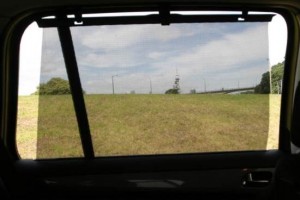Australians should be used to driving in hot weather, but every year motorists get caught out. If you’re a new motorist, learning to drive, this guide gives you all the dangers you might face when driving in hot weather.
Sun dazzle or sun strike
With long summer evenings there is a longer time period that the sun lingers on the horizon making it more difficult for you to see east in the morning and west in the evening. A clean windscreen or a clean, unscratched visor are important as any dirt and scratches diffract bright light making it difficult to see.
Glare reflecting off other vehicles can sometimes be a problem, too.
Dehydration and heat exhaustion
 Cars can heat up quickly. If your car doesn’t have air conditioning and you are sitting in the hot sun, the temperatures inside the car can reach 60 degrees Celsius in just a few minutes if you don’t open the windows. Even with the windows open the temperature can be much hotter than the outside temperature. For this reason you should never leave pets or children in your vehicle – always take them with you. Some cars have sun blinds built into the windows which can help, but still won’t prevent the inside of a car heating up if left in the sun. Read our full article about driving dehydrated.
Cars can heat up quickly. If your car doesn’t have air conditioning and you are sitting in the hot sun, the temperatures inside the car can reach 60 degrees Celsius in just a few minutes if you don’t open the windows. Even with the windows open the temperature can be much hotter than the outside temperature. For this reason you should never leave pets or children in your vehicle – always take them with you. Some cars have sun blinds built into the windows which can help, but still won’t prevent the inside of a car heating up if left in the sun. Read our full article about driving dehydrated.

I took this in Sydney in sunny weather. The rider would be hot if he had to wait too long
You also need to carry something to drink if you are going on a long journey. Caffeinated drinks might help keep you awake, but they are also diuretics which can cause your body to lose water.
Sunstroke is when your body overheats. It can be problematic for motorcyclists in heavy protective gear if riding in slow traffic where the wind chill doesn’t provide any cooling effect. Motorcyclists can suffer from searing heat while they are waiting at traffic lights, but then significant wind chill while travelling at 100kph.
Slick roads after rain
Long dry spells don’t give the usual road grime a chance to be washed away. Oil and dust accumulate on the tarmac and when it first rains mixes with the water to create an extremely slippery surface. This eventually washes away, but be wary for the first couple of hours if it’s just rained after a long dry spell.
Flash floods
When the weather has been warm for a while the earth can get compacted. A short, heavy tropical storm can cause flash floods until the surface water disperses.
Sunburn
Trucker’s arm is where your right arm gets a tan through hanging it out the window, whereas your left arm stays untanned. Remember to apply sunscreen; if you get sunburned this increases your long term chances of getting melanoma skin cancer.
Increased risk of injury in a crash
Motorcyclists often succumb to wearing less protective clothing when it’s hot and this puts them at risk of more severe injuries in an accident.
Melting tarmac
Melting tarmac creates slippery patches that can be a problem, especially for motorcyclists. They will also throw up tar splashes onto your paintwork, which you can remove with commercially available cleaners from an auto parts store.
Mechanical stress
Hot weather can challenge your vehicle’s cooling system. If you have to stop on the side of the road and wait for your car to cool down you’ll be glad you brought extra drinks.
Other road users
Hot weather tends to bring out other road users towing boats and jetskis which can create more overtaking hazards.
